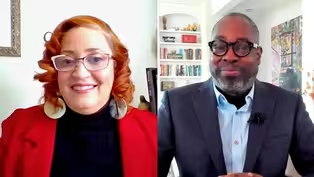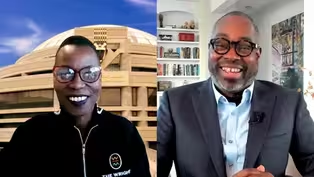
Detroit artist’s James Baldwin exhibit at The Wright Museum
Clip: Season 53 Episode 2 | 9m 16sVideo has Closed Captions
Detroit artist Sabrina Nelson’s “Frontline Prophet: James Baldwin” exhibit at The Wright.
A unique traveling art exhibit, “Frontline Prophet: James Baldwin,” is on display at The Charles H. Wright Museum. The exhibit, created by Detroit-based artist Sabrina Nelson, explores the past and present influences of the late writer and activist James Baldwin. Host Stephen Henderson talks with Nelson about her exhibit, which is on display through February 28.
Problems playing video? | Closed Captioning Feedback
Problems playing video? | Closed Captioning Feedback
American Black Journal is a local public television program presented by Detroit PBS

Detroit artist’s James Baldwin exhibit at The Wright Museum
Clip: Season 53 Episode 2 | 9m 16sVideo has Closed Captions
A unique traveling art exhibit, “Frontline Prophet: James Baldwin,” is on display at The Charles H. Wright Museum. The exhibit, created by Detroit-based artist Sabrina Nelson, explores the past and present influences of the late writer and activist James Baldwin. Host Stephen Henderson talks with Nelson about her exhibit, which is on display through February 28.
Problems playing video? | Closed Captioning Feedback
How to Watch American Black Journal
American Black Journal is available to stream on pbs.org and the free PBS App, available on iPhone, Apple TV, Android TV, Android smartphones, Amazon Fire TV, Amazon Fire Tablet, Roku, Samsung Smart TV, and Vizio.
Providing Support for PBS.org
Learn Moreabout PBS online sponsorship- And finally today, we wanna remind you that an exhibition celebrating the life of author and civil rights activist, James Baldwin, is at the Charles H. Wright Museum through the end of February.
It's called "Frontline Prophet: James Baldwin."
I spoke last summer with Sabrina Nelson, she is the artist whose work is featured in this exhibit.
Tell me about "Frontline Prophet: James Baldwin," this exhibit at the Wright.
- Well, I can tell you the beginnings of it and how it started.
You know, a lotta people will always ask, "How did you get so obsessed with James Baldwin?"
And I have to respond that I wasn't obsessed with James Baldwin, but I was invited by our Detroit poet laureate, Jessica Care Moore, to travel with her in 2016 to the James Baldwin Conference, at American University of Paris.
I was on the plane with her, Melba Boyd, and Magdalena from U of M, and I just wanted to do as much reading as I could on James Baldwin before I got there, because I knew more about Beauford Delaney, who was his mentor, who's an artist, more so than I knew about James Baldwin.
And so I was invited by Jessica to paint live during her plenary session.
- Hmm.
- So I'd never drawn Baldwin before, and I'd done as much reading, and when I got there and I started drawing his image, I felt something.
Now, I don't know how many people feel things spiritually, but I felt somethin', and my hairs raised on my arms.
And I had never drawn him before.
But I felt like he touched me, he came to me.
And then I asked, after I experienced my poltergeist moment, (laughing) I asked, I said, you know, "If you're here, I need you to teach me how to know you."
- Ah.
- And sometimes, I feel like the spirit has jokes because it went deep and heavy.
And I've learned so many things about James Arthur Baldwin and his life, and his activism, and his artivism as well.
- Yeah.
- This is how it started.
So it started off with small sketchbooks and drawing him during what we normally call Inktober.
I didn't like the word prompts, so I changed it to Blacktober.
And I said, "Who can I draw?"
This is of course after I came back from Paris.
"Who can I draw every day for 31 days?"
Which ended up into 91 days 'cause I didn't stop.
- Wow, wow.
- So that's the beginning of this "Frontline Prophet."
- Yeah.
- And then with Ashara and Omo Misha, who are my co-curators, they came to my studio and said, you know, "Hey, what are you doing with these old sketchbooks, what are they?"
And I said, "Well, I did a study of James Baldwin," and she was like, "What are you doing with them?"
And I said, "Well, they're in my studio," and she says, "We should do a show."
And I'd already talked to a friend of mine, named Mikael Rashid, about it, but I wasn't really sure how I was gonna do it.
And with Ashara suggesting that she'll travel, we've traveled now to six cities, and now after being home, we will go to Paris to make it a full circle.
And so it's been a really amazing journey.
It's been a great journey with Ashara Ekundayo, and also Omo Misha McGlown from Irwin House Gallery, for those listening in Detroit.
- Mm-hmm, yeah.
- Both of these women, all of us are born in Detroit, raised here, and live between Oakland, California and Detroit, or Harlem, New York and Detroit.
- And Detroit.
- Yeah.
So we are all here, and this is how it started, and this is how it sort of spread into the, Ashara named the show by the way, "Frontline Prophet: James Baldwin," that you can see now at the Charles H. Wright Museum, up until February 28th.
- Yeah.
So one of my favorite things about Baldwin is what I'll call complication.
It's not just that his struggle was about being African American and male in a society that didn't value him for that reason, you know, he had struggles on many different fronts.
And I think when we do right by him, we tell that story, we tell the story of those complications, of that nuance.
When you were hearing from him, from this poltergeist, what did he say to you about complication, about that nuance?
- Well, I just felt his spirit, and when I draw him, I feel like I've baptized myself and his image enough to know his eyes, his expressions, his voice.
When I walk in a room and I hear a recording and I hear it's his voice, I'm like, "Whoa," you know?
So I think my job is to reopen a portal, if you will, so that he can reenter in this time.
He's never really left.
And during his physical time here with us, there were no awards given to him.
And there were lots of activists who felt like he was using his platform / star power to just be seen in the moment, but he really was concerned about, you know, what it means to be Black in this country.
Where he would say things like, "I picked the cotton, I built the homes, I tilled the land," and have a country that doesn't think of you as this important being, you know?
And so I think having his visual image and also augmented reality in the museum will allow people who've forgotten who he was, what his words were.
And how he walked and left a very solid footprint here with things that were happening then, back in the '50s, the '60s, and now still happening here, and how we value beings less than we value land.
- Yeah, yeah.
- And so with him dying at 63 years old, and I know he died in 1987, and I was very pregnant with Mario.
- Oh yeah.
(laughing) - And so just thinking about the time that he went through between 1924 and his timeline of 1987, and what he witnessed.
And so when you ask a young person, who may be much younger than Mario, who James Baldwin was or is, sometimes they'll go, "Well, I've heard of him, but I don't really know him."
So I think bringing his image back, celebrating his centennial life, adding the augmented reality will allow them to hear his voice, will allow people to see his face, and think about his political views and him as a poet, who also told the truth about who we were in this country, and how he had to leave this country to go away to find out who he really is or was.
You know, sort of when you're running away, you really are running to find yourself.
- Mmm.
- And you are always with you, no matter where you go.
So I think that journey to Paris gave him enough quietness to find who James Arthur Baldwin was.
And so I think he said to me, maybe not in words, you know, "I'm coming back, I'm coming through your work."
And through the work of these co-curators in this museum, and these journeys that we've had from Harlem to New Orleans, from New Orleans to Oakland, from Oakland to Chicago, and now in Detroit, and then to Paris, how we can hold this frontline prophet up and say, "Hey, he did some work here, and I think we need to revisit his cliff notes 'cause he said some things.
He even told kids in Oakland, "You can beat the president.
Maybe not in this lifetime as history is right now, but within your lifetime, you can be the president of this United States."
- Yeah, yeah.
National Day of Racial Healing addresses effects of racism
Video has Closed Captions
Clip: S53 Ep2 | 9m 6s | New Detroit, Inc. focuses on advancing racial equity for National Day of Racial Healing. (9m 6s)
The Wright Museum hosts celebration for MLK Day 2025
Video has Closed Captions
Clip: S53 Ep2 | 5m 16s | The Wright Museum hosts its annual celebration for Martin Luther King, Jr. Day 2025. (5m 16s)
Providing Support for PBS.org
Learn Moreabout PBS online sponsorship
- News and Public Affairs

Top journalists deliver compelling original analysis of the hour's headlines.

- News and Public Affairs

FRONTLINE is investigative journalism that questions, explains and changes our world.












Support for PBS provided by:
American Black Journal is a local public television program presented by Detroit PBS

